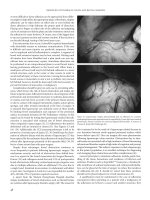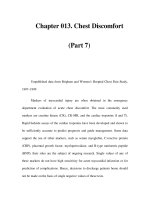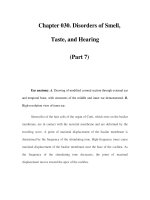Transoesophageal Echocardiography - part 7 pps
Bạn đang xem bản rút gọn của tài liệu. Xem và tải ngay bản đầy đủ của tài liệu tại đây (108.86 KB, 16 trang )
Ventricular function
85
Table 4.1 Diastolic dysfunction summary
Normal
Impaired
relaxation Pseudo-normal
Restrictive
pathology
DT (ms) 160–240 >240 160–200 <160
IVRT (ms) 70–90 >90 >90 <70
E/A 1–2 <1 1–1.5 >2
A
dur
/PV
Adur
A>PV
A
A>PV
A
A<PV
A
A<<PV
A
PV
S
/PV
D
PV
S
>PV
D
PV
S
>>PV
D
PV
S
<PV
D
PV
S
<<PV
D
E
VTI
/A
VTI
E>AE<AE>AE>>A
Valsalva E: A ↓↓ ↓↓ ↓↑ ↓↓
Summary of diastolic dysfunction (Table 4.1)
RV function
Normal RV function
RV = triangular/crescent-shaped
Contains muscle ridges = trabeculae carneae
Moderator band: large muscle bundle from low IVS to ant RV wall
Velocity of RV ejection:
↑ gradually
peaks later than LV
persists longer than LV
RV volume determined by Simpson’s method
RV dysfunction
Volume overload
Dilated RV
Flattening of IVS (moves to left)
86 Transoesophageal Echocardiography
Pressure overload
(1) Chronic:
e.g. pulmonary hypertension
RV hypertrophy (RV free wall thickness > 5 mm)
progresses to RV dilatation/free wall hypokinesia
(2) Acute:
e.g. PE
RV can compensate to PAP < 40 mmHg
RV dilatation with TR
RV free wall hypokinesia
IVS flattening in diastole
RA/IVC dilatation
Multiple choice questions
1. Foranadult female, left ventricular hypertrophy is defined as a left
ventricular mass of greater than
A 12 mg/m
2
B 120 mg/m
2
C 12 g/m
2
D 120 g/m
2
E 1.2 kg/m
2
2. If the left ventricular internal diameter in systole is 30 mm and the
left ventricular internal diameter in diastole is 45 mm, the fractional
shortening is approximately
A 15%
B 25%
C 33%
D 50%
E 66%
3. In mitral regurgitation
A ejection fraction is preserved until late in the disease
Ventricular function
87
B there is commonly left ventricular concentric hypertrophy
C prognosis is poor if fractional shortening is less than 42%
D there is a reduction in left ventricular end diastolic volume
E there is a reduction in left ventricular end systolic
volume
4. The following statements regarding segmental left ventricular
function are all true except
A regional wall motion abnormality occurs 5–10 beats after coronary
occlusion
B right coronary artery supplies the inferior wall
C pacing can cause a regional wall motion abnormality
D left circumflex coronary artery supplies the lateral wall
E post-myocardial infarction scarring often causes wall thickening
greater than 9 mm
5. A normal isovolumic relaxation time is
A 7–9 µs
B 70–90 µs
C 0.7–0.9 ms
D 7–9 ms
E 70–90 ms
6. Isovolumic relaxation
A commences when the mitral valve closes
B involves a 35% reduction in left ventricular volume
C terminates when left atrial pressure exceeds left ventricular
pressure
D terminates when the mitral valve closes
E commences when the aortic valve opens
7. Chamber stiffness is affected by all of the following except
A left ventricle volume
B right ventricle pressure
C pericardial pressure
D pleural pressure
E ascending aortic compliance
88 Transoesophageal Echocardiography
8. Regarding impaired relaxation, there is
A an increase in E wave maximum velocity
B a decrease in A wave maximum velocity
C an increase in the E/A ratio
D an increase in pulmonary vein flow A wave duration
E an increase in pulmonary vein flow D wave velocity
9. Regarding transmitral flow
A impaired relaxation causes shortening of the E wave acceleration time
B restrictive pathology causes an increase in E wave deceleration time
C inspiration causes increased E wave velocity
D increasing heart rate causes reduced E/A ratio
E restrictive pathology causes increased A wave velocity
10. Regarding restrictive pathology
A isovolumic relaxation time is often greater than 90 ms
B deceleration time is usually less than 160 ms
C E/A ratio is greatly reduced
D transmitral A wave duration greatly exceeds pulmonary vein flow A
wave duration
E pulmonary vein flow S wave velocity greatly exceeds D wave velocity
11. Increasing age causes
A increase in isovolumic relaxation time
B increase in E wave maximum velocity
C decrease in E wave deceleration time
D decrease in A wave maximum velocity
E increase in E/A ratio
12. The following statements about the right ventricle are all true except
A the normal right ventricle is crescent shaped
B it contains muscle ridges called trabeculae carneae
C in right ventricular hypertrophy the free wall is usually thicker than
15 mm
D its volume can be determined using Simpson’s method
E acute pulmonary embolism can cause right ventricular free wall
hypokinesia
5
Cardiomyopathies
Hypertrophic obstructive cardiomyopathy
Definition and epidemiology
Unexplained hypertrophy of non-dilated LV
Prevalence ∼ 1–2% of population
Familial autosomal dominant ≈ 55%
Sporadic ≈ 45%
Features
Asymmetric septal hypertrophy
(1) Type I: anteroseptal
(2) Type II: panseptal
(3) Type III: extensive, sparing only posterior wall
(4) Type IV: apico-septal
IVS: posterior wall thickness ratio > 1.3:1
Systolic anterior motion (SAM) of anterior MV leaflet (AMVL)
= functional subaortic stenosis
Common with large, redundant AMVL
Anterior motion of antero-lateral papillary muscle
Venturi effect causes suction of AMVL into LVOT
LVOT P G > 36 mmHg (velocity > 3 m/s)
CW Doppler → ‘dagger-shaped’ pattern with late peaking
90 Transoesophageal Echocardiography
Mitral regurgitation
Magnitude of MR greatest in mid- to late-systole
Early AV closure
Mid-systolic AV closure
Dilated cardiomyopathy
Definition
Four-chamber enlargement with impaired RV and LV
systolic function
Aetiology
Idiopathic
IHD
Post-partum
Post-CPB
Toxins – alcohol, cobalt, adriamycin, snake bites
Metabolic – acromegaly, thiamine, and selenium deficiency
Infection – post-viral, Chagas’ disease
Inherited – Duchenne’s muscular dystrophy, SC anaemia
Systemic disease – haemoachromatosis: Fe deposition within myocytes
in epicardial region → fibrosis
Features
Four-chamber dilatation
RV and LV systolic dysfunction +/− diastolic
dysfunction
Normal wall thickness
Increased LV mass
Cardiomyopathies
91
LV inflow directed postero-laterally
May have predominantly RV dilatation (Coxsackie B infection)
Restrictive cardiomyopathy
Causes
Idiopathic
Amyloid
Sarcoid
Storage diseases
Carcinoid
Endocardial fibroelastosis
Endomyocardial fibrosis
Features
Biatrial dilatation
Normal ventricular size and systolic function
Restriction to RV and LV filling
Echo-dense RV and LV walls
Amyloidosis
Deposition of abnormal proteins between myocardial fibres, in
PMs, in conductive tissue and in pericardium
Increased RV and LV wall thickness
‘Speckled’/granular appearance
RV/LV size and systolic function normal
Biatrial dilatation
Diffuse valvular thickening (MV and TV)
Small/moderate effusion
92 Transoesophageal Echocardiography
Sarcoidosis
Non-caseating granulomas
Affects LV free wall, IVS (conduction tissue), PMs causing MR and LV
dilatation with RWMA
Storage diseases
Accumulation of abnormal metabolites
(1) Glycogen (Pompe’s/Cori’s): LVH +/− SAM
(2) Lipid (Fabry’s) ≡ amyloidosis
(3) Mucopolysaccharide (Hurler’s, Sanfilipo etc.): MV thickening
Carcinoid
Malignant tumour with hepatic metastases
Endocardial injury due to hormones (serotonin, kinins)
RA wall/TV/PV thickening
Usually TR + PS
Primary bronchogenic tumour can cause left-sided lesions
Endocardial fibroelastosis
Diffuse endocardial hyperplasia
Increased chamber size and wall thickness
AV/MV fibrosis
Endomyocardial fibrosis (Loeffler’s endocarditis)
Assoc. with:
idiopathic hypereosinophilic syndrome, acquired
hypereosinophilia
Fibrosis affecting :
MV/TV MR/MS
TR/TS
subvalvular apparatus
apex
Cardiomyopathies
93
Increased risk of thrombus formation
Preserved LV systolic function
Multiple choice questions
1. Regarding hypertrophic obstructive cardiomyopathy
A the prevalence is 0.1%
B type II septal hypertrophy is limited to the apex
C more than 65% of cases are sporadic
D type III septal hypertrophy is limited to the posterior wall
E the interventricular septum : posterior wall thickness ratio is usually
greater than 1.3
2. Systolic anterior motion of the anterior mitral valve leaflet
A creates a functional sub-aortic stenosis
B is common with a small, redundant anterior leaflet
C is associated with posterior motion of the antero-lateral papillary
muscle
D is associated with a fall in the pressure gradient across the left
ventricular outflow tract
E creates a ‘dagger-shaped’ pattern with early peaking on application of
continuous wave Doppler
3. The following statements about dilated cardiomyopathy are all true
except
A it may be caused by cobalt toxicity
B there is an increase in left ventricular mass
C left ventricular inflow is directed antero-laterally
D left ventricular wall thickness is normal
E left ventricular diastolic dysfunction may occur
4. Features typical of restrictive cardiomyopathy include
A right ventricular dilatation in amyloidosis
B aortic and mitral valve fibrosis in endocardial fibroelastosis
C reduced left atrial size in sarcoidosis
D reduced left ventricular systolic function in endomyocardial fibrosis
E echolucent ventricular walls in amyloidosis
6
Valvular heart disease
Mitral valve
Mitral stenosis
Aetiology
Rheumatic
Degenerative calcification
Congenital
Vegetations
Parachute MV (chordae attached to single PM)
Infiltrative (fibrosis, amyloid)
Ergot, hypereosinophilia, non-valvular (myxoma, thrombus)
Features
MMode
↓E-F slope of AMVL
Anterior motion of PMVL
2-D
Reduced leaflet motion
Leaflet thickening
Reduced orifice size
AMVL ‘hockey stick’ appearance
‘diastolic doming’ – body of leaflets more pliable and receive some of
blood flowing from LA to LV
LA – enlarged/‘smoke’/thrombus/AF
LAA–‘smoke’/thrombus/reduced Doppler velocities
LV – small/underfilled
Signs of pulmonary hypertension (RA/RV enlarged)
Valvular heart disease
95
Table 6.1 Assessment of mitral stenosis by mean pressure
gradient (MG) and mitral valve area (MVA)
Severity MG (mmHg) MVA (cm
2
)
Normal 0 4–6
Mild <6 2–4
Moderate 6–12 1–2
Severe > 12 <1
A
E
CWD
Fig. 6.1
Rheumatic MS
Calcification of MV and subvalvular apparatus
Fusion of commissures and chordae
‘Fish-mouth’ MV orifice
Assessment of MS severity
(1) Planimetry:
trace ‘fish-mouth’ in transgastric basal SAX view
affected by plane and gain
TOE underestimates degree of MS
(2) Transvalvular gradient: uses modified Bernoulli equation
P = 4V
2
Use mean pressure gradient (MG) (Table 6.1)
Trace around E and A waves (Fig. 6.1)
Underestimates degree of MS if AI present
96 Transoesophageal Echocardiography
Three-chamber
Two-chamber
a b
Fig. 6.2
(3) Continuity equation:
Flow =Velocity ×Area
V
1
A
1
=V
2
A
2
A
2
=V
1
A
1
/V
2
MVA = V
LV OT
× A
LV OT
/V
MV
MVA = VTI
LV OT
× A
LV OT
/VTI
MV
Inaccurate with AI (affects VTI
LV OT
)
(4) Colour flow Doppler area (Fig. 6.2)
MVA =
(
π/4
)
ab
MVA = 0.785
ab
(5) Pressure half time (PHT) (Fig. 6.3)
Time taken for pressure to fall by
1
/
2
Inaccurate with AI: AI →↓PHT → overestimates MVA
MVA = 220/PHT
(6) Depressurization time (DepT) (Fig. 6.3)
MVA = 750/DepT
(7) Proximal isovelocity surface area (PISA). Flow converges uniformly
and radially towards a small orifice, creating concentric isovelocity
layers
98 Transoesophageal Echocardiography
(8) Gorlin formula: used in cardiac catheter lab
MVA = CO/[(DFT ×HR)(44×C×
√
MG)]
CO = cardiac output
DFT = diastolic filling time
HR = heart rate
C = orifice constant (for MV = 0.85)
MG = mean gradient
MVA = CO/[(DFT ×HR)(37.5
√
MG)]
Mitral regurgitation
Aetiology
(1) Congenital
Cleft MV
Double-orifice MV
Mitral arcade
(2) Acquired
Rheumatic
Ischaemic
MV prolapse
PM dysfunction/rupture
Chordal dysfunction/rupture
Vegetation
(3) Other
MV aneurysm
Annular calcification
Fibrosis
Tumours
Carpentier classification
I: normal leaflet motion:
dilated annulus
leaflet perforation
Valvular heart disease
99
II: excessive leaflet motion:
myxomatous disease
PM/chordal rupture
MV prolapse
flail
III: restricted leaflet motion:
rheumatic disease
chordal tethering (ischaemia)
Assessment of MR severity
(1) Jet length
Trivial<1.5 cm
Mild1.5–3 cm
Moderate 3–4.5cm
Severe>4.5 cm
(2) Jet length/LA length
Trivial <25%
Mild 25–50%
Moderate 50–75%
Severe >75%
(3) Jet area
Trivial<1.5 cm
2
Mild1.5–4 cm
2
Moderate 4–7 cm
2
Severe>7cm
2
(4) Jetarea/LA area
Mild <20%
Moderate 20–40%
Severe>40%
(5) Qualitative
Signal strength with CW Doppler
i.e. large volume MR gives strong CW signal
(6) Regurgitant volume (RV)
Difference between MV diastolic flow and AV systolic flow,
assuming no AI
100 Transoesophageal Echocardiography
PWD D
A
PWD
D
PV
S
reversal = severe MR
PV
S
blunting = moderate M
R
S
A
S
Fig. 6.5
Severe >60 ml
RV =MV vol −LVOT vol
RV =
(
Area
MV
×VTI
MV
)
−
(
Area
LV OT
×VTI
LV OT
)
(7) Regurgitant fraction
Trivial<20%
Mild 20–30%
Moderate 30–50%
Severe>50%
(8) Effective regurgitant orifice (ERO): from PISA
Mild<0.2 cm
2
Moderate 0.2–0.4 cm
2
Severe>0.4 cm
2
ERO = 6.28r
2
×V
alias
/V
MR
(9) Pulmonary venous flow (Fig. 6.5)
Moderate PV
S
blunting
SeverePV
S
reversal
(10) Vena contracta
Narrowest portion of jet downstream from orifice
>0.5 cm ≡ ERO >0.4 cm
2
Valvular heart disease
101
e.g. 2
°
HB
CWD Systolic MR
Diastolic MR
A A A
E
Fig. 6.6
Diastolic MR
Retrograde flow from LV to LA during diastole (Fig. 6.6)
Causes include AV block, atrial flutter, severe AI, high LVEDP
Mitral valve prolapse
Displacement of MV leaflet >3mmabove level of annulus
Occurs mid/end systole as annulus moves towards apex
Bilateralleafletprolapse: 75–90%
Posteriorleaflet prolapse: 10–20%
Anteriorleafletprolapse: 3–5%
Associated with infective endocarditis, MR, sudden death from
ventricular arrhythmias
Aortic valve
Aortic stenosis
Aetiology
(1) Congenital
Uni-/bi-/quadricuspid valve









